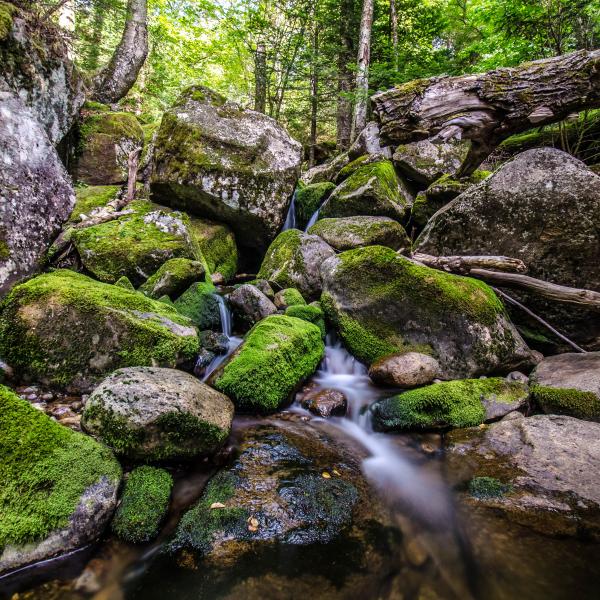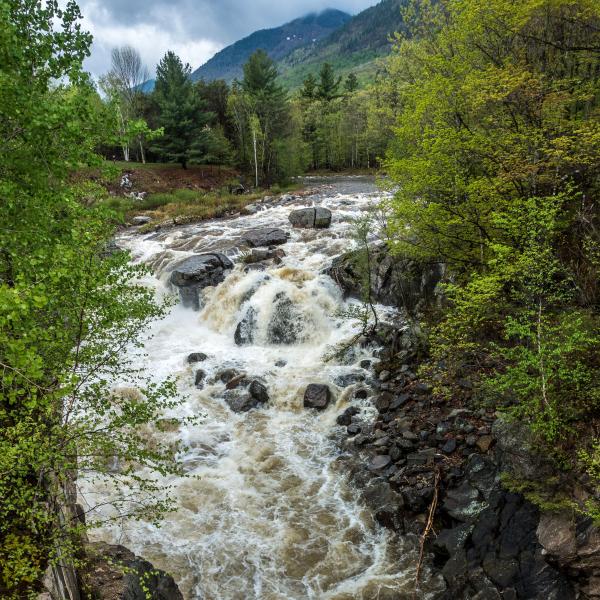Stream Barriers
The Threat
Under rural roads throughout the Ausable watershed, streams are routed through plastic, steel, or concrete structures often significantly narrower than the width of the streams at normal flow. Undersized, collapsed, or poorly designed road crossings fragment natural stream pattern and ecosystems, contribute to erosion, and exacerbate flooding. They block native fish and other aquatic organisms from moving upstream to the cooler waters and habitat they need to survive and reproduce. High flows forced through undersized culvert pipes or bridges increase water velocities, eroding the bed and banks at their outlets, and in some cases, creating large drop-offs to the streams below.
Debris builds up quickly at the upstream ends of undersized culvert pipes, backing up natural flows, flooding roads, and requiring ongoing maintenance by local road crews. Undersized bridges may allow the passage of most debris, but still back up flows, impounding water upstream, eroding banks and widening the channel. Streambanks at either end of undersized road crossings are often eroded. Stripped of plants and the root systems that stabilize them, the banks collapse, adding more sediment and compromising the habitat of fish and other wildlife essential to a healthy stream. It is a vicious cycle. The good news is that these problems can be solved.
AFC's Response - Climate Ready Culverts
The Ausable Freshwater Center (AFC) is improving transportation infrastructure in the Ausable watershed, increasing its resilience to the impacts of climate change. Working with the US Fish and Wildlife Service and the Adirondack Chapter of The Nature Conservancy we're developing a cost effective model for retrofitting or replacing culverts that block fish passage and exacerbate flood damage to local roads and private property. The goals of this Climate Ready Culvert program are to improve stream connectivity, habitat for fish and other aquatic animals, and community resilience to flooding through the redesign and replacement of undersized culverts.
We're tackling the highest priority culverts, working side-by-side with town and county road crews. Our model will serve as a template for construction of smaller culvert replacements (under 20’ wide) that allows more towns to replace more culverts as funding becomes available. Upfront costs of a culvert replacement are significant, $150,000 or more, but the trade-off is little to no maintenance and reduced repair costs for the 70-year life span of the new structure – a significant savings for many towns.
Check out our past culvert projects or read summaries of our work in 2020 on Jay Mountain Road over Otis Brook, in 2019 on Glen Road over Otis Brook, in 2017 on Nugent Road over a tributary of Rocky Branch, in 2016 on Jay Mountain Road over Otis Brook, and in 2015 on Lenny Preston Road over Courtney Brook.
Occassionally, AFC and our partners choose to retrofit a stream - rebuilding the stream to reestablish its form and function and reconnect it through the existing culvert. In many cases, these culverts aren't ideal but are capable of allowing a stream to function. One recent example of this is the Otis Brook crossing of Glen Road in the Town of Jay. This slightly undersized 4-sided box with its smooth concrete bottom isn't ideal for fish or stream health. In addition, in 2011, flood flows from Hurricane Irene scoured the bed and banks of the oulet leaving a 4-5 foot scour hole, an impassible drop from the culvert to water surface, and badly eroded banks. However, instead of advocating a costly full replacement, AFC and the U.S. Fish and Wildlife Service have opted to retrofit this road-crossing. Work was completed in 2019.
What You Can Do
Spread the word. Talk to your community leaders about improving road crossings in your community. Take the time to visit the improved crossings found on the map above. If you have questions, contact AFC. If you like what you see, thank your town and county leaders for building smart in your community.
Join AFC! Staying informed is the best way to follow this issue and to support better culverts in your community and throughout the Ausable watershed.


